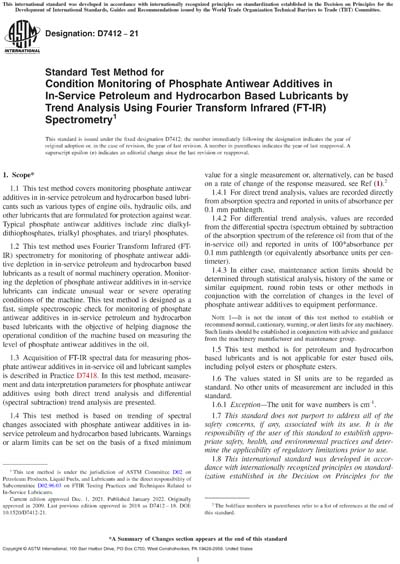Historical
ASTM D7412-21
Standard Test Method for Condition Monitoring of Phosphate Antiwear Additives in In-Service Petroleum and Hydrocarbon Based Lubricants by Trend Analysis Using Fourier Transform Infrared (FT-IR) Spectrometry
1.1This test method covers monitoring phosphate antiwear additives in in-service petroleum and hydrocarbon based lubricants such as various types of engine oils, hydraulic oils, and other lubricants that are formulated for protection against wear. Typical phosphate antiwear additives include zinc dialkyldithiophosphates, trialkyl phosphates, and triaryl phosphates.
1.2This test method uses Fourier Transform Infrared (FT-IR) spectrometry for monitoring of phosphate antiwear additive depletion in in-service petroleum and hydrocarbon based lubricants as a result of normal machinery operation. Monitoring the depletion of phosphate antiwear additives in in-service lubricants can indicate unusual wear or severe operating conditions of the machine. This test method is designed as a fast, simple spectroscopic check for monitoring of phosphate antiwear additives in in-service petroleum and hydrocarbon based lubricants with the objective of helping diagnose the operational condition of the machine based on measuring the level of phosphate antiwear additives in the oil.
1.3Acquisition of FT-IR spectral data for measuring phosphate antiwear additives in in-service oil and lubricant samples is described in Practice D7418. In this test method, measurement and data interpretation parameters for phosphate antiwear additives using both direct trend analysis and differential (spectral subtraction) trend analysis are presented.
1.4This test method is based on trending of spectral changes associated with phosphate antiwear additives in in-service petroleum and hydrocarbon based lubricants. Warnings or alarm limits can be set on the basis of a fixed minimum value for a single measurement or, alternatively, can be based on a rate of change of the response measured, see Ref (1).2
1.4.1For direct trend analysis, values are recorded directly from absorption spectra and reported in units of absorbance per 0.1 mm pathlength.
1.4.2For differential trend analysis, values are recorded from the differential spectra (spectrum obtained by subtraction of the absorption spectrum of the reference oil from that of the in-service oil) and reported in units of 100*absorbance per 0.1 mm pathlength (or equivalently absorbance units per centimeter).
1.4.3In either case, maintenance action limits should be determined through statistical analysis, history of the same or similar equipment, round robin tests or other methods in conjunction with the correlation of changes in the level of phosphate antiwear additives to equipment performance.
Note 1:It is not the intent of this test method to establish or recommend normal, cautionary, warning, or alert limits for any machinery. Such limits should be established in conjunction with advice and guidance from the machinery manufacturer and maintenance group.
1.5This test method is for petroleum and hydrocarbon based lubricants and is not applicable for ester based oils, including polyol esters or phosphate esters.
1.6The values stated in SI units are to be regarded as standard. No other units of measurement are included in this standard.
1.6.1Exception - The unit for wave numbers is cm-1.
1.7This standard does not purport to address all of the safety concerns, if any, associated with its use. It is the responsibility of the user of this standard to establish appropriate safety, health, and environmental practices and determine the applicability of regulatory limitations prior to use.
1.8This international standard was developed in accordance with internationally recognized principles on standardization established in the Decision on Principles for the Development of International Standards, Guides and Recommendations issued by the World Trade Organization Technical Barriers to Trade (TBT) Committee.
ASTM International [astm]

